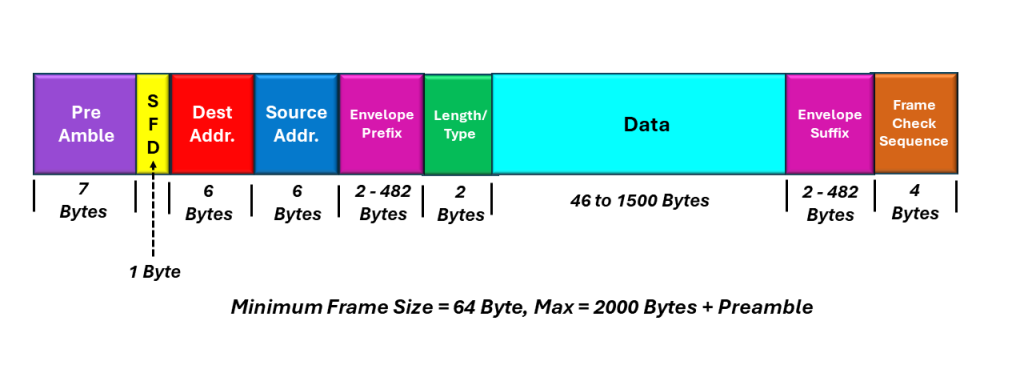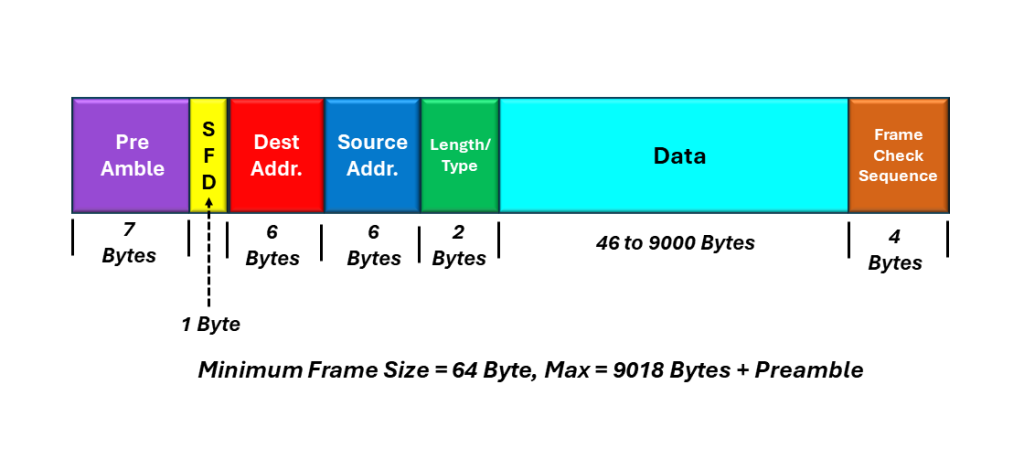The purpose of this blog post is to list, itemize, and briefly describe the various types of Ethernet frames that are in use today.
This blog post will also provide links to blog posts with more details about these various Ethernet frames and the various fields (within these frames).
In short, there are five different types of Ethernet frames (that are widely used in networking today).
- DIX Ethernet Frame
- IEEE 802.3 Compliant (or Basic) Ethernet Frame
- IEEE 802.3 Compliant Frame, with Q-Tag
- IEEE 802.3 Compliant Ethernet Frame with Envelope Prefix and/or Suffix
- Jumbo Frame
I present the byte format of each of these types of Ethernet frames in the figures below.
The DIX Ethernet Frame
The DIX Ethernet frame is the “DEC, Intel, Xerox” (DIX) Standard Ethernet frame.
A consortium of these three companies created this particular Ethernet format.
I present an illustration of the DIX Ethernet frame below in Figure 1.

Figure 1, Illustration of the DIX Ethernet Frame
NOTE: The DIX and IEEE 802.3 Compliant (Basic) Ethernet frames each have a maixmum size (or length) of 1518 bytes (plus the Preamble).
I present a more detailed description of the DIX Ethernet frame in another blog post.
IEEE 802.3 Compliant (or Basic) Ethernet Frame
I illustrate the IEEE 802.3 (Basic) Ethernet frame below in Figure 2.

Figure 2, Illustration of the IEEE 802.3 (Basic) Ethernet frame.
NOTE: The DIX and IEEE 802.3 Compliant (Basic) Ethernet frames each have a maixmum size (or length) of 1518 bytes (plus the Preamble).
I present a more detailed description of the IEEE 802.3 (Basic) Ethernet frame in another blog post.
IEEE 802.3 Compliant Frame with Q-Tag
We call this type of a frame a “Q-Tag” frame, because it includes the IEEE 802.1Q Tag. The literature also calls this tag the VLAN or priority tag. We discuss VLAN (Virtual LANs) in another post.
I illustrate the IEEE 802.3 Compliant Frame with Q-Tag below in Figure 3.

Figure 3, Illustration of the IEEE 802.3 Compliant Frame with Q-Tag.
The maximum length of the IEEE 802.3 Frame (with Q-Tag) is 1522 bytes (plus Preamble).
I present a more detailed description of the IEEE 802.3 Compliant Frame – with Q-Tag, in another blog post.
IEEE 802.3 Complaint Ethernet Frame with Envelope Prefix and/or Suffix
I illustrate the IEEE 802.3 Compliant Ethernet Frame with Envelope Prefix and/or Suffix, below in Figure 4.

Figure 4, Illustration of the IEEE 802 Compliant Ethernet Frame with Envelope Prefix and/or Suffix
The IEEE 802.3 Compliant – Envelope Frames, can have a maximum length of 2000 bytes (plus the Preamble).
I present a more detailed description of the IEEE 802.3 Compliant Ethernet frame with Envelope Prefix and Suffix in another blog post.
Jumbo Frame
I illustrate the Jumbo Frame before in Figure 5.

Figure 5, Illustration of the Jumbo Frame
The Jumbo Frame can be a large as 9018 bytes (in length) plus the Preamble.
I present a more detailed description of the Jumbo Ethernet frame in another blog post.

